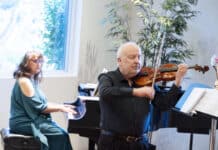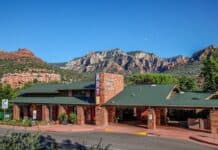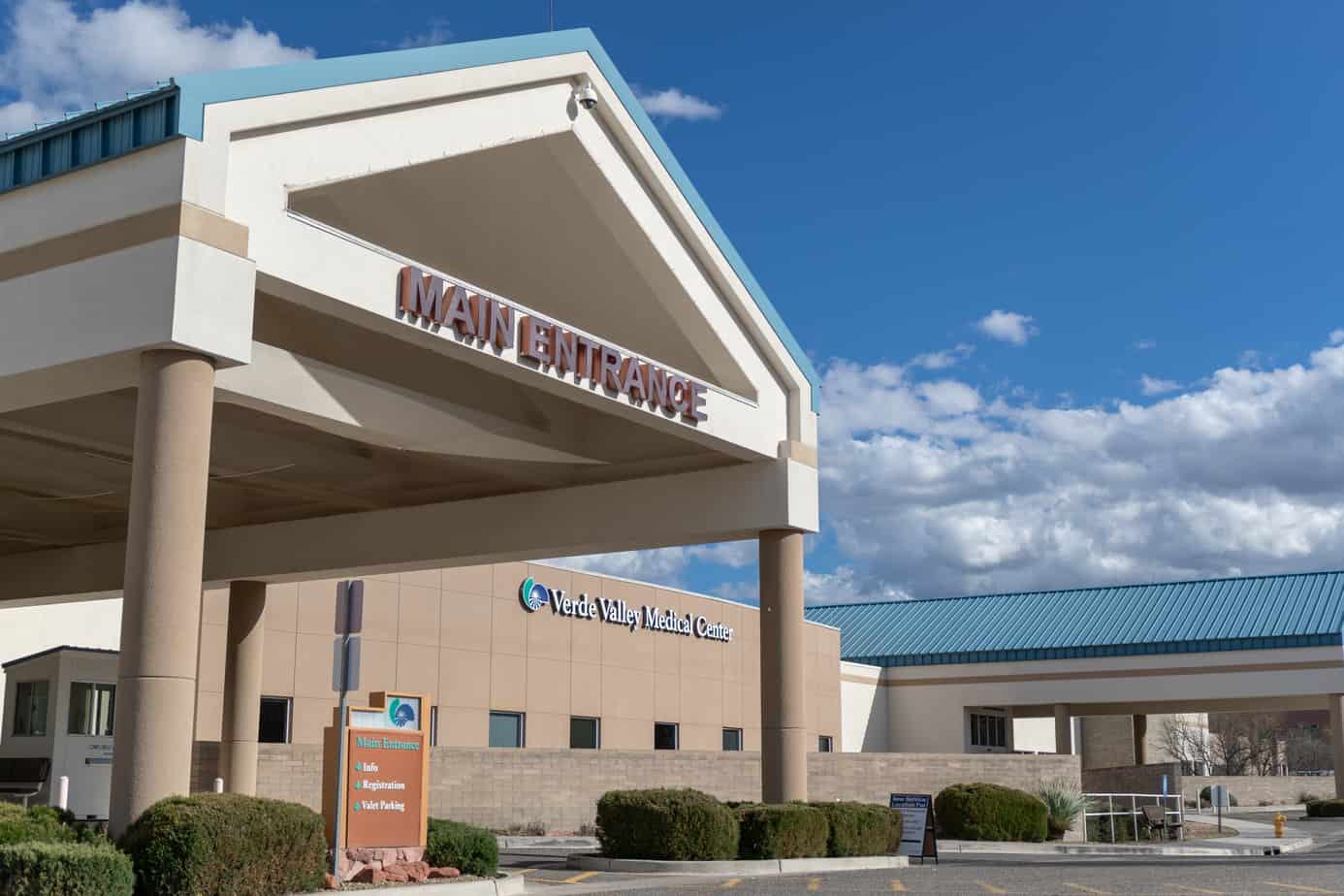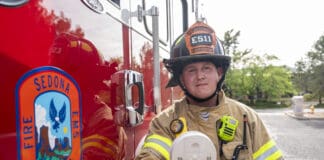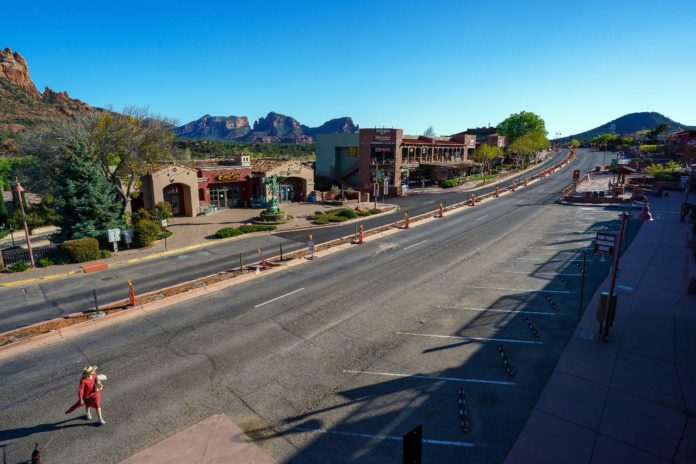
It’s been one year since COVID-19 began reshaping our lives.
On March 15, 2020, Arizona Gov. Doug Ducey ordered all school districts to close down for the foreseeable future due to COVID- 19, which had been declared a pandemic by the World Health Organization four days earlier on March 11.
On March 17, 2020, the Arizona Department of Health Services issued guidance calling for cancelling and postponing all events of over 10 people and calling for physical distancing in all businesses when possible. On March 19, the governor ordered all restaurants to be dine-out only and halted elective surgeries, and on March 30, the governor issued his “Stay Home, Stay Healthy, Stay Connected” exective order shutting down all but essential services and seeking to limit the spread of the SARS-CoV-2 coronavirus through reducing person-to-person spread.
In the one year since those initial COVID restrictions, over 830,000 Arizonans have been confirmed for COVID-19 infections. Over 16,000 have died. In the Verde Valley, there have been over 5,700 confirmed COVID-19 cases, with over 130 COVID-related deaths.
Looking back on the past year, local leaders feel that the communities in the area did the best they could in an awful situation, though the costs were enormous.
Initial Reactions
“I was scared to death when everything around us shut down, but people really came together,” Cottonwood Mayor Tim Elinski said. “I think we did very well — we quickly formed a team of stake holders and business leaders to come together and do an assessment of community resources and an assessment of the need. I wish we’d been able to keep our infection rates lower — there’s a lot of obstacles to that, including the politicization of mask wearing.”
“We’ve had over half-a-million tragic individual deaths in the country. I know every hospital, every community has had their fair share,” Verde Valley Medical Center Chief Medical Officer Dr. Leon Pontikes said. “We made the best of a bad situation. We have learned along the way like everyone has with this pandemic. People have developed the expertise. We’re better equipped administratively.”
At a case rate of roughly 8,600 per 100,000 residents and a death rate of roughly 200 per 100,000 residents, the Verde Valley appears to have done better than the national average, but the wounds of the virus remain clear a year later.
Government Response
“It saddens me to know that 27 citizens of Camp Verde lost their lives.” Camp Verde Mayor Dee Jenkins said. “That’s the reality of this — those families that suffered because of the disease and how it affected their families and lost their lives. And of course the people that have been affected by loss of job and reduced hours. That’s sad, and I hope that we can get back to work.”
None of the local mayors or public health leaders reached by Larson Newspapers said that they have any regrets about their response to the virus, feeling that everything that could have been done was done, and the results compared to the national average speak for themselves.
Camp Verde was the only locality in the area that did not institute a mask mandate, and Jenkins — who was vice mayor at the time of the decision in the spring — stands by that choice based on the public sentiment against a mandate that the town’s government encountered.
Mayor Sandy Moriarty of Sedona cites her decision to impose a mask mandate on June 24, within a week of the governor giving local governments the permission to do so on June 17, as one of her best decisions as mayor during the past year.
“I came back from [a meeting of local mayors after the governor’s order] and knew I had to have an emergency proclamation drafted,” Moriarty said. “Only in an emergency does a mayor have any power at all. This is my 50th year in the area and I don’t recall ever having an emergency called in Sedona.”
Moriarty held a meeting with her City Council but she imposed the order without taking a vote.
Elinski faced significant blowback after he overruled a losing 4-3 vote by the Cottonwood City Council against a mask mandate at a June 19 meeting by immediately issuing a mayoral proclamation requiring masks anyway. The council later voted to limit the mayor’s powers to overrule council in similar circumstances as a result. Elinski’s order also had no penalty, unlike the defeated measure.
But Elinski stands by both his decision to issue the proclamation and his decision to first call the vote that he later overruled, saying he would not have done things differently if given the chance.
“I’ve thought long and hard about that,” Elinski said. “It was contentious, it was difficult, but I wouldn’t do anything differently. I think it was important that we were able to have a discussion as council and have our constituents be able to voice their concern. I regret having had to use the power of proclamation. I wish that we had a different outcome of the vote. But if it happened again, I’d do exactly the same thing.”
Mayor Robyn Prud’homme-Bauer of Clarkdale, who unseated longtime incumbent Mayor Doug Von Gausig in the August election, argues that the town of Clarkdale, which imposed mask mandates and strict restrictions on government offices, handled the virus well and did what it could, but that the difficulty of fighting the virus went beyond what local governments could do.
“I’m not sure we could have done anything more, because it was so unknown what this virus would do,” Prud’homme-Bauer said. “I think the hardest part was understanding the confusing executive orders, so that we could give a message out to not just businesses but residents …. It wasn’t hard to take the precautions, but when people were not admitting that it was serious, I think that was the frustration. None of us had ever seen this.”
Medical Response
“It was a brand new virus when it hit the world. It spread really rapidly — it probably spread before we knew it spread here in Arizona,” Yavapai County Community Health Services Director Leslie Horton said. “The misinformation out there was really a difficult battle early on. There’s been a lot of fear about COVID, and you have people who quickly and readily bought into misinformation about it that was available out there, especially early on. If I think back a few years ago and even the first few months of the pandemic, there was a lot of misinformation. It was really tough to sort through in people’s minds and help them understand what was fact vs. what was myth, and what was the information that we needed to know vs. what was fear-based.”
Horton said that the county health department’s staff were often overwhelmed over the past year due to a limited staff with limited resources dealing with a crisis bigger than anything they had dealt with before. She also spoke of angry responses from the public, all the way to the point of people breaking into her office and threatening to hurt her.
“Anything you do you’re going to get a lot of people happy and a lot of people angry,” Horton said. “I guess it comes with the pandemic. I’ve never been a fearful person …. It’s been quite a year of learning and one I hope not to have to relive.”
“It was difficult work,” Pontikes said of the VVMC staff who were front-line during the pandemic. “The staff felt very relieved when the vaccine became available. The fact that the work they did was so lonely — donning hoods and masks and being in a patient room on end. And then when they went home a lot of the staff felt isolated from their families, because they didn’t want to put their families at risk.”
“For every health care worker, this has obviously been the worst year to live through,” Pontikes said. “It’s something they’ll carry forever — 20 years from now they’ll be telling war stories about 2020.”
Horton feels that for the most part the county handled the virus extremely well, but that in hindsight, she wished schools had been able to stay open more, something she often advocated over the past year even as her office called for strict precautions.
Community Response
“It’s not even the education,” said Cottonwood- Oak Creek School District Superintendent Steve King, who said in hindsight he would have preferred to keep the schools open for much more of the past year. “What I see is the emotional impact and trauma of what they have seen. Whether it’s their parents going through stress, their families going through stress …. That stuff has an impact on the lives of kids.”
Some of the largest effects of the virus on the area have been for local businesses and employees, especially in industries such as food service and entertainment, with local restaurants and bars forced to severely limit occupancy or close down entirely.
“I think the hardest has been on our bars that don’t serve food, because the information hasn’t always been clear about how to go forward on how to reopen, and still today it’s still not clear,” Prud’homme-Bauer said. “I think that’s been the frustration.”
However, the economic impact in the Verde Valley ended up being less severe than initially expected, with many businesses able to make do through continued tourism.
“I’m grateful that we’re doing business in the Verde Valley, as opposed to a major city. We still had tourism due to our open spaces,” said Eric Jurisin, who as the head of the Haunted Group owns eight restaurants in Cottonwood and Jerome. According to Jurisin, the customer base for his restaurants shifted, away from local residents and tourists from other parts of Arizona, to visitors from other states. “We thought the world was ending and it didn’t.”
Jurisin also said that the heavy restrictions on dining practices — masks, heavy cleaning and limited occupancy — allowed staff to mostly remain safe. While there were employees who contracted the virus, it was usually individual cases that were promptly isolated, not outbreaks among the whole staff.
Local governments that initially expected that their budgets would be destroyed by the economic shutdowns ended up actually seeing sales tax revenues increase, mostly due to collections on online sales.
The ability of localities to collect sales taxes goes back to a 2018 U.S. Supreme Court Decision, South Dakota v. Wayfair, which ended up having a massive effect on localities during the pandemic by allowing local jurisdictions to collect sales tax on purchases made online regardless of where the seller was located.
“That happened pre-pandemic and thank God it did,” Moriarty said. “When the pandemic came along everyone started ordering everything online. Every city in the Verde Valley saw sales taxes go up.”
Vaccinations
A year after the pandemic, the Verde Valley is in a good position for a potential rebound, especially with vaccinations speeding up. While supply of vaccine doses continues to hamper vaccinations, local leaders have praised Spectrum Healthcare and YCCHS for their efforts to distribute them as quickly as possible. Yavapai County’s vaccination rate stands at 22.8%, higher than both the statewide average of 20.5% and the national average of 19.3%. As of Friday, March 12, over 53,000 people in Yavapai County have received at least one dose of the vaccine, with over 34,000 having received a second.
“There’s a sense of optimism, a light at the end of the tunnel,” Pontikes said. “But it’s tenuous. There’s still uncertainty about the weeks and months to come.”
Local leaders hope that the spread of vaccinations can mean an end to the current crisis, but also note their caution about how soon the area can return to normal with the threat still real.
“I don’t like the term ‘going back to normal,’” Moriarty said. “I think we’re going forward to a new normal.”
“It’s changed everything,” Prud’homme-Bauer said. “It’s changed how we do business. It’s changed how kids are educated. It’s changed how we live our lives. It’s a major paradigm shift because of how we live our lives.”
“I’ve seen and heard some really sad things, but this whole crisis in our community has brought out a lot of good in some folks,” Elinski said. “I’ve been so humbled by people’s willingness to donate their time, donate their money to give to our community. There’s so many stories of people who have given their all.”



